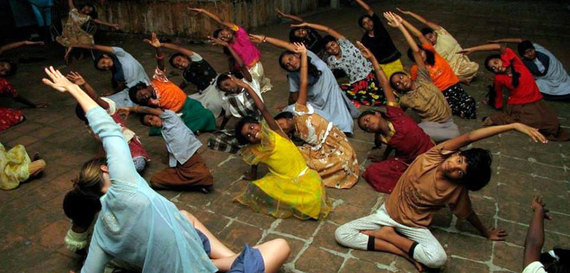This is an interview with Sylvia Jabaley, MPA, Program Coordinator for Homes of Hope India-US and co-founder of Yoga Village; and Kristin Cooper, Founder of Wilmington Yoga Center (North Carolina) and Kunga Yoga.
Sylvia began her yoga practice in 2003, and began her work with Homes of Hope in 2012 after serving as a public middle and high school teacher for 10 years. Sylvia coordinates partnerships with yoga studios and Homes of Hope India orphanages, as well as local service yoga partnerships.
Kristin founded the Wilmington Yoga Center in 2000, and Kunga Yoga in 2006, after volunteering with orphans from the Rwandan genocide, and Homes of Hope India. She is the founder of the Kunga Yoga Teacher Training School, and Kunga Journeys yoga service retreats.
Rob: What originally motivated you to do this work, and what continues to motivate you? How, if at all, has that motivation changed over time?
Sylvia: It was the stories from friends and yoga teachers who returned from the annual Kunga Journeys trips to our first orphanage in Kochi, India: about Reena, a 6-year-old who had been blinded to make her a "better beggar;" their tears as they remembered embracing a girl hungry for loving touch. Each year, the Kunga family returns to celebrate each girl's school progress, emotional victories, and life in general. And when I visited for the first time, I gained approval because I knew "yoga aunties and yoga uncles."
Kristin: After my husband and I spent our honeymoon volunteering at Home of Hope in Kochi, I was mesmerized by the incredible beauty, grace, and alive-ness of the girls, astounded by their "back stories." One was sold into a brothel by her grandmother at age 11, another was living under a train station and dancing for money during the day, and some had "no" story -- they were found abandoned and brought in by the police. They did not know their age or their name.
I was also impressed with the orphanage, and Home of Hope itself. The girls worked together to clean and do other chores. The systems and scheduling of the orphanage were remarkable -- the older girls would mentor the younger girls, everyone was on time for the school bell, they eagerly did their afternoon homework, and all, somehow, often with only six or eight nuns running the show. This little orphanage was a tautly -- but lovingly -- run ship!
My motivation has not changed, to help give these girls a chance at a decent life, so that they may become the next generation of leaders for India.
What did you know about the population you are working with before you began teaching? What were some of the assumptions you had about this population, and how have those assumptions changed?
Kristin: I worked with children orphaned during the genocide in Rwanda, but had never worked with children from India. Their common thread was the very resilient spirit that children have if provided with consistent love and continuity. They need shelter and food, but I could see they most craved feelings of belonging and knowing that someone cared about them.
Sylvia: My assumptions about our goals were transformed by realization that when the girls become women, they will still encounter illness, poverty, and misogyny. This reality erased my assumption that we are caring for little girls. We are actually healing and rebuilding lives -- from the streets to a life of potential. Today, we are realizing the value of our work as the little girls we've known for years turn the corner to become empowered women in their own communities.
What are two distinct ways that your teaching style differs from the way you might teach in a studio, and what are the reasons for these differences?
Kristin: In a studio, I tend to teach with the goal of helping my students reduce stress from busy lifestyles, and development of an inner-focus through meditation, to counter the activities of modern life in the U.S.
With the girls in India, I've found that they most enjoy Thai massage, partner yoga, and expansive, "outer- focused" yoga. I believe that they greatly benefit from receiving loving touch, and they love watching an adult yoga teacher acting silly! It is rare that they share a dynamic with an adult that is not structured. With our volunteers, we have the opportunity to teach them yoga as a source of play, connection, laughter. The giggles abound, but when meditation time comes they are very observant.
In general, I think that in the west, we tend to practice very seriously at times, sometimes with great dogma and expectation. I feel that we could learn so much from the girls about how to lighten up and enjoy.
Sylvia: Kristin includes the girls of Homes of Hope among her gurus, and so do I. Every morning the girls lead their own yoga practice to awaken their bodies and prepare their minds. Older girls lead the practice, cueing inhales and exhales with a series of asana. Their practice is very "stripped down." No music, no games. Just a simple, austere practice, much like the modest life they lead. When I lived with the girls in October of 2013, I was privileged to share their practice.
What has been the greatest challenge in your teaching experience and what tools have you developed for addressing that challenge? What advice would you give to anyone who is going to teach in the population you work with?
Sylvia: Each trip to India reinforces our drive to do more, serve more. With an estimated 500,000 homeless girls on the streets of India as you read this, the need is staggering. We invite others to partner in our work, first, to build orphanages. Working with Indian Rotarians, local builders and architects, Indian officials and other professionals, we are ready to meet the need.
Kunga Yoga volunteers visit the Kochi Home of Hope annually. This is but one of four orphanages, with a fifth under construction. We hope that yoga teachers in other cities who wish to serve Indian girls will work with us to begin regular visits -- in essence to "adopt" one of our Homes. With these visits -- and ongoing email or Skype communication -- they can cultivate friendship and a yoga practice that the girls can maintain on their own. As the service yoga community blossoms, we envision a global family in support of the girls and young women of Homes of Hope.
Kristin: I'm thrilled about the LetsBuildanOrphanage.com campaign and the community of yoga studios signed on to work with us. Seven studios in North and South Carolina are already working. Our goal is $300,000 by December 1, 2014. We are also challenging each studio to take on one or two rooms-to-be-built in the orphanage, such as a kitchen or dorm room. I know that we can do it!
How has this work changed your definition of service? Your definition of yoga? Your practice?
Sylvia: When I began to practice yoga, I separated my public service from my self-serving yoga practice. I went to the mat to escape my challenging work. But in the family of Homes of Hope and Kunga Yoga, my personal yoga practice and my purpose converge. And every time I step on the mat with a community of yogis in our global family, I am invigorated -- even transformed.
Editor: Alice Trembour
Stay connected with Give Back Yoga Foundation as we share the gift of yoga with the world, one person at a time, by following us on Facebook, Twitter and Google+ and by subscribing to our newsletter.
Are you a yoga instructor giving back to underserved populations? E-mail Executive Director Rob Schware if you're interested in being interviewed for this series.

